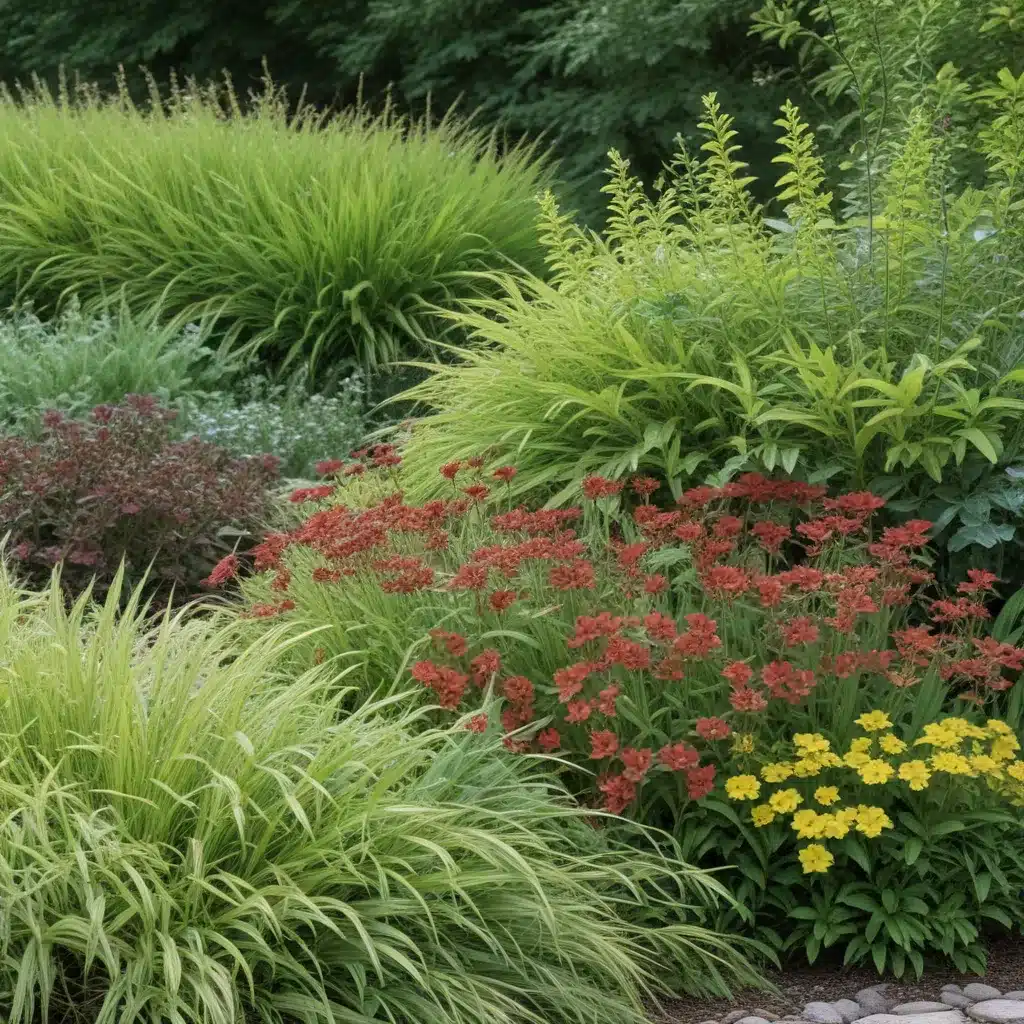
Crafting a captivating garden landscape is a nuanced endeavor, requiring a keen eye for harmonious texture and dynamic tone. TriCounty Tree Care’s design specialists understand that thoughtful layering of perennials, ornamental grasses, and groundcovers is essential for cultivating year-round visual interest and ecological vitality. By strategically incorporating a diversity of plant forms, foliage textures, and bloom periods, gardeners can create lush, naturalistic compositions that delight the senses and nourish local wildlife.
Texture Composition
Perennial Textures
Perennials offer a wealth of captivating textures, from the delicate, ferny foliage of Geranium to the bold, architectural leaves of Hosta. Finely-textured plants like Salvia and Echinacea can provide airy contrast to broader-leaved specimens, while evergreen perennials like Helleborus and Bergenia lend a sense of stability through the dormant season. By juxtaposing coarse, medium, and fine-textured perennials, designers can craft multi-dimensional plantings that engage the eye.
Grass Textures
Ornamental grasses bring a dynamic, undulating quality to the landscape, their slender blades catching the breeze and creating a soothing, shimmering effect. The wispy, thread-like foliage of Muhlenbergia and Nassella contrasts beautifully with the bold, arching forms of Miscanthus and Panicum. Finely-textured Festuca and Calamagrostis lend a sense of delicacy, while the broad, strappy leaves of Imperata and Cortaderia add weight and substance.
Groundcover Textures
Groundcovers weave a tapestry of textures at the base of the garden, from the velvety mats of Sedum to the shiny, scalloped leaves of Vinca. Trailing plants like Hedera and Galium spill over edges, softening hardscapes, while low-growing Thymus and Phlox form dense, cushiony mats. The diversity of groundcover forms, from needle-like to broad and succulent, allows designers to create visual rhythm and depth.
Layering Techniques
Vertical Layering
Establishing a sense of depth and hierarchy is crucial in garden design. Tall, vertical elements like the wispy Panicum and stately Miscanthus grasses draw the eye upward, while lower-growing perennials and groundcovers anchor the composition. Strategically placing mid-height shrubs and small trees further enhances the multilayered effect, creating a lush, immersive experience.
Horizontal Layering
In addition to vertical structure, thoughtful horizontal layering is key to crafting visually compelling plantings. Spreading, mat-forming groundcovers like Sedum and Thymus unify the composition, while taller perennials and grasses punctuate the design at regular intervals. Grouping plants of similar heights, such as Echinacea and Penstemon, creates rhythmic bands of color and texture.
Combination Layering
The most dynamic gardens often employ a blend of vertical and horizontal layering techniques. Towering Miscanthus grasses rise above billowing Aster and Solidago perennials, while low-growing Vinca and Heuchera spill over the edges of raised beds. This multidimensional approach allows designers to craft complex, naturalistic scenes that captivate the viewer from every angle.
Perennial Plant Selection
Perennial Varieties
TriCounty Tree Care’s experts recommend a diverse palette of perennials to anchor the garden. Flowering varieties like Echinacea, Rudbeckia, and Monarda provide vibrant splashes of color throughout the growing season, while foliage-focused plants such as Heuchera, Brunnera, and Hakonechloa offer rich, nuanced textures. Evergreen perennials like Helleborus, Pachysandra, and Buxus lend a sense of structure and stability in the off-season.
Perennial Characteristics
When selecting perennials, it’s crucial to consider their growth habits, seasonal interest, and site requirements. Upright, clumping varieties like Penstemon and Veronica create bold, architectural accents, while spreading, mat-forming plants like Sedum and Phlox provide seamless groundcover. Many perennials, such as Coreopsis and Salvia, offer extended bloom periods, while others, like Heuchera and Carex, captivate with their foliage throughout the year. Carefully matching perennials to the available sun, soil, and moisture conditions is essential for long-term success.
Ornamental Grass Integration
Grass Types
Ornamental grasses bring a sense of movement and rhythm to the garden, their graceful, swaying forms complementing the more static perennials and groundcovers. Warm-season grasses like Panicum, Andropogon, and Sorghastrum flourish in full sun, while cool-season varieties such as Calamagrostis, Festuca, and Deschampsia thrive in partial shade. Grass-like plants, including Carex, Juncus, and Liriope, offer similar textural qualities and ecological benefits.
Grass Design Considerations
When incorporating ornamental grasses, designers must consider their mature height and spread to ensure harmonious integration. Towering Miscanthus and Cortaderia make bold statements as focal points, while lower-growing Festuca and Carex excel as edging or groundcover plants. The diverse leaf textures of grasses, from the fine, feathery blades of Muhlenbergia to the broad, arching foliage of Imperata, create visual rhythm and contrast. The gentle, undulating movement of grasses also adds a soothing, sensory element to the garden.
Groundcover Incorporation
Groundcover Functions
Groundcovers serve vital roles in the landscape, from stabilizing soil and suppressing weeds to providing year-round visual interest. Trailing plants like Hedera and Galium cascade over walls and raised beds, softening hardscapes and adding a sense of lushness. Spreading, mat-forming groundcovers such as Sedum and Thymus form dense, cushiony carpets that inhibit weed growth and retain moisture. Carpeting groundcovers like Vinca and Pachysandra create seamless, evergreen blankets that unify the garden composition.
Groundcover Selection
When selecting groundcovers, designers must consider their growth habits, site requirements, and aesthetic qualities. Trailing groundcovers like Hedera and Lamium excel in shaded areas, while spreading plants like Sedum and Phlox thrive in sunny locations. Carpeting groundcovers such as Vinca and Pachysandra offer reliable, year-round coverage, while more dynamic, flowering varieties like Thymus and Phlox add seasonal pops of color. Carefully combining groundcovers of varying heights, textures, and growth patterns creates visually captivating, ecologically resilient plantings.
By thoughtfully layering perennials, ornamental grasses, and groundcovers, TriCounty Tree Care’s design specialists craft garden landscapes that engage the senses and support local biodiversity. This multidimensional approach to texture and tone allows for the creation of lush, naturalistic scenes that evolve with the seasons, providing year-round visual interest and ecological vitality. To learn more about TriCounty Tree Care’s comprehensive design services, please visit www.tricountytreecare.com.


